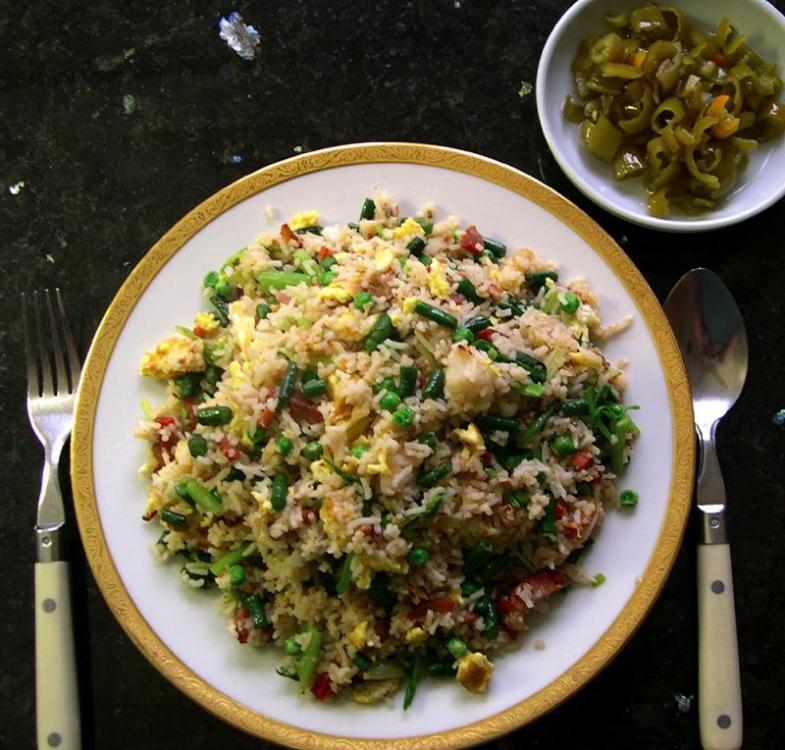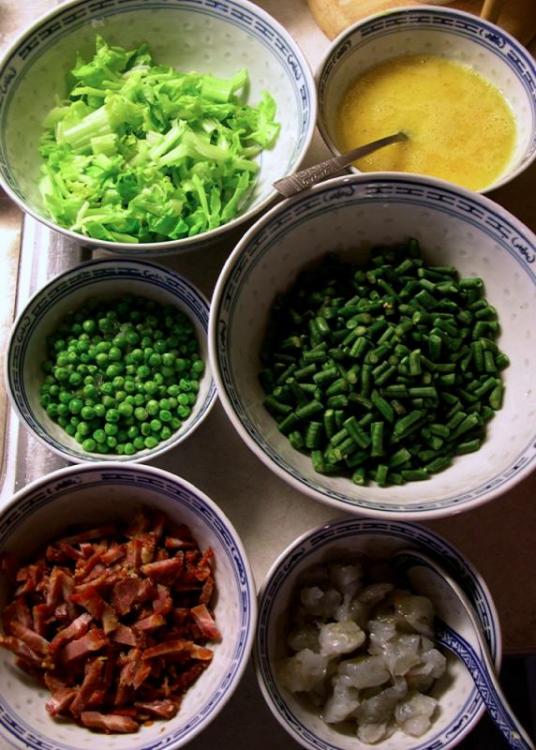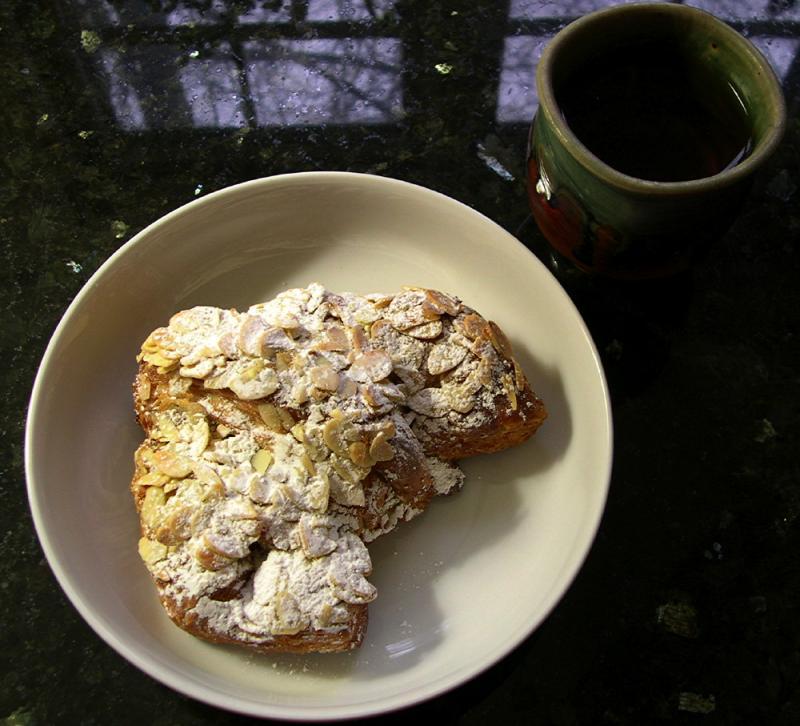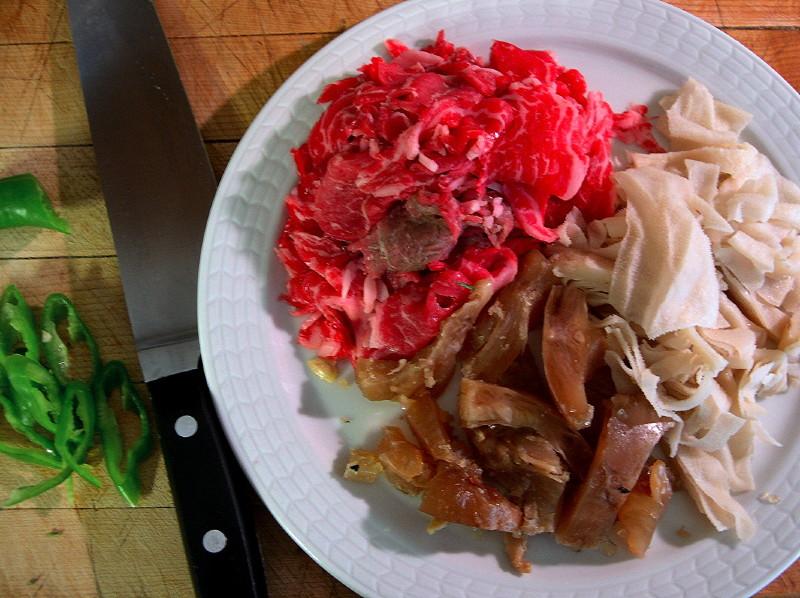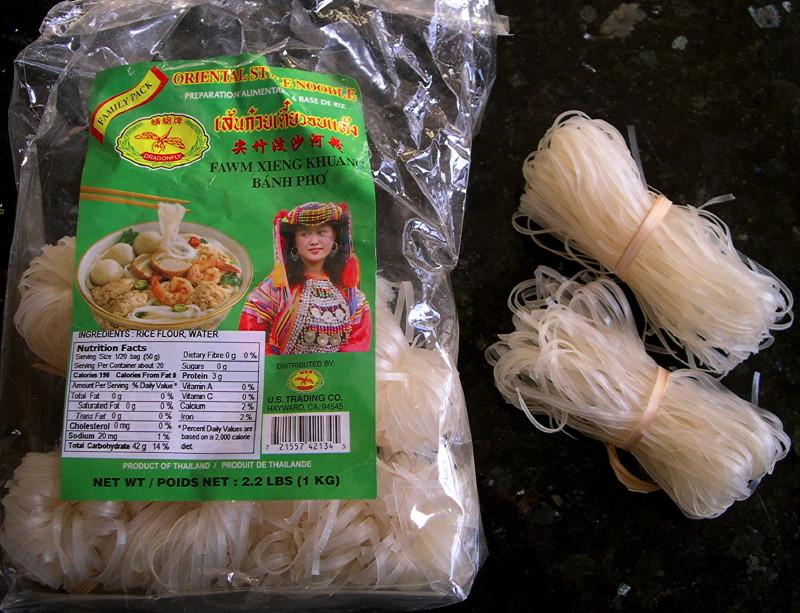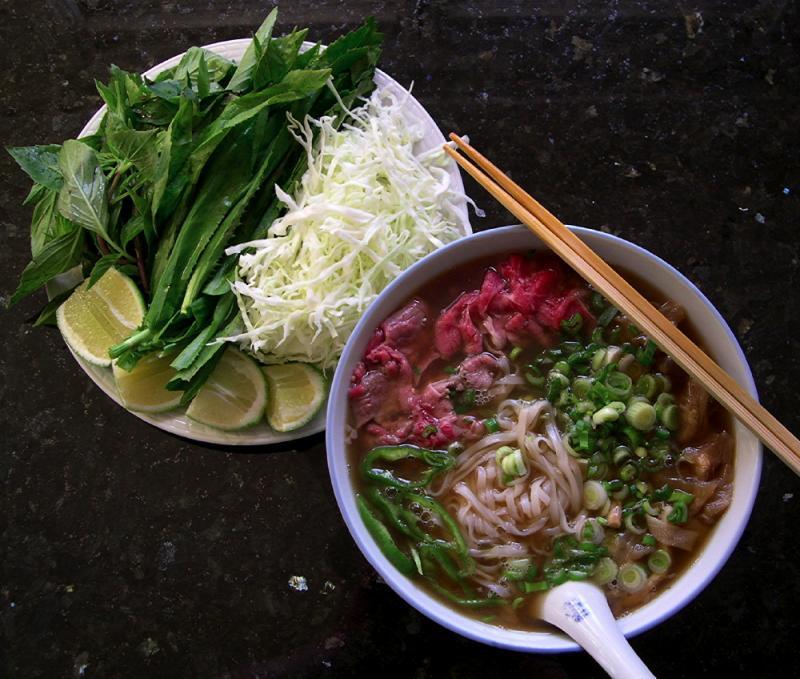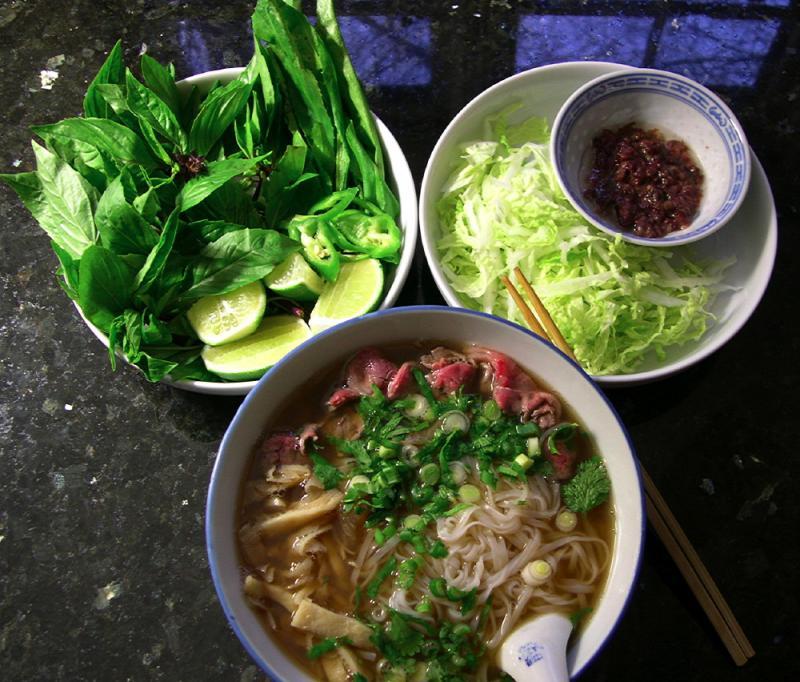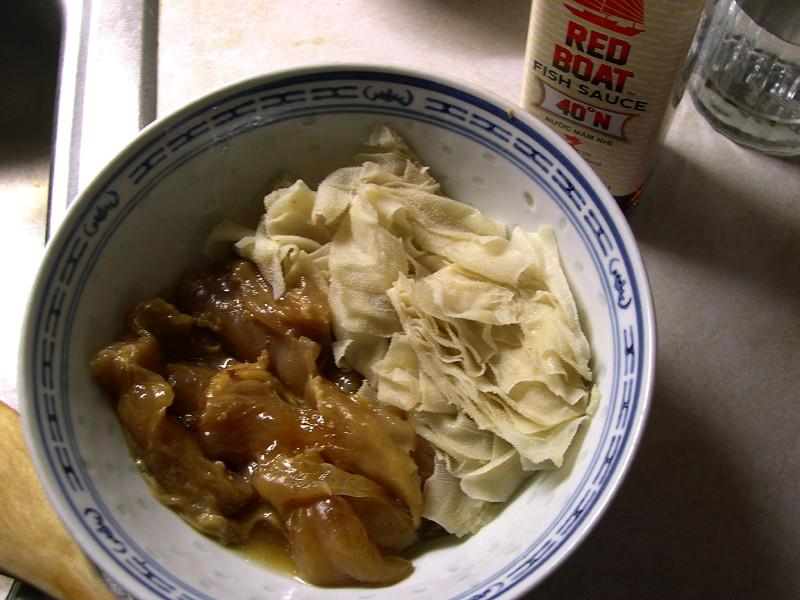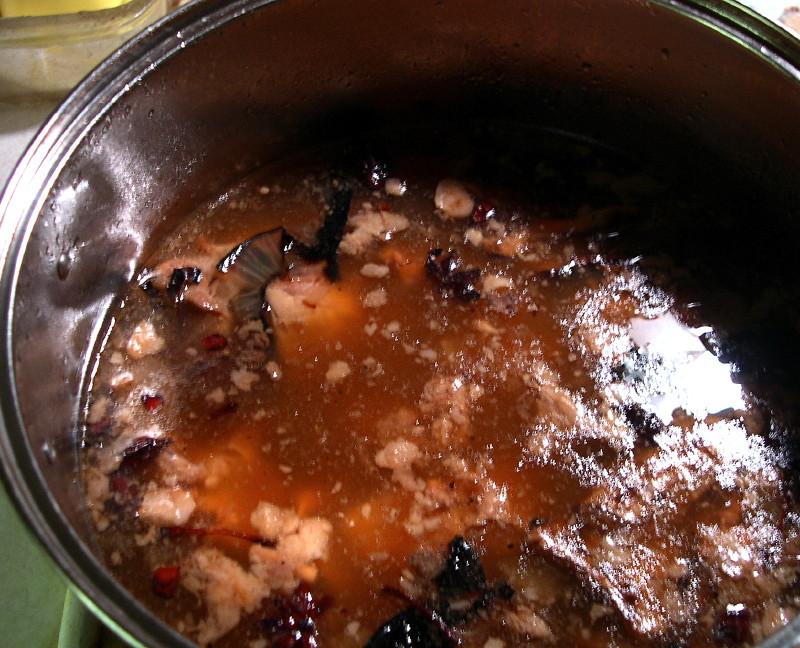-
Posts
3,810 -
Joined
-
Last visited
Content Type
Profiles
Forums
Store
Help Articles
Everything posted by huiray
-

"Fried Rice" Chinese type: in China or Restaurants here
huiray replied to a topic in Food Traditions & Culture
JTravel, very interesting. Well, as for that darkness of the fried rice you were shown how to do, that very first bottle on the left (at the front) on the counter is dark soy sauce. ("老抽王") Nevertheless, it looks like they didn't use it with "wild abandon". Here's the Baidu article on 老抽 and the Google translation. Just wondering - what was the composition of your group and was the demonstration specially arranged for your group or was it a "standard class" that you were invited to sit in on? -

"Fried Rice" Chinese type: in China or Restaurants here
huiray replied to a topic in Food Traditions & Culture
The fried rice that is known as "Yeung Chow" (or Yangzhou) fried rice ("chow fan") in SE Asia and Southern China is typified by the use of char-siu. I think of the use of lap-cheong or ham as variations or versions of it. The "style" of the dish doubtless plays a part, see the images here: https://www.google.c...iw=1124&bih=957 It is true that the more commonly known "Yeung Chow" fried rice is said to be the Guangzhou (Canton) version, which would also appear to be the version more known outside China and in North America. The dish may not actually have been invented in Yangzhou, although nowadays the dish - if made IN Yangzhou - has certain specified ingredients which do not include either lap-cheong or char-siu. NB: Yangzhou is north of Shanghai, quite far from Guangzhou (Canton). http://zh.wikipedia....‚'飯 http://translate.goo...om/translate... The English wikipedia entry... http://en.wikipedia....Chow_fried_rice ...if one is interested in it. :-) -

"Fried Rice" Chinese type: in China or Restaurants here
huiray replied to a topic in Food Traditions & Culture
It depends on how strict or how limited one's definition of "Chinese Food" is. Turmeric fried rice is not unknown amongst the Chinese communities in SE Asia, as a dish incorporating spices used in those lands, and amongst the non-Chinese. The Thais/Thai-Chinese, Malaysian-Singaporean Chinese, Indonesians/Indonesian-Chinese all have variations upon it ("黃薑炒飯"; Nasi Goreng Kunyit; etc etc) with various add-ins and ingredients in it as well of course. In American-Chinese take-out joints it is used too (or "curry powder" instead). It even appears as recipes on Chinese websites, as new influences are absorbed into the cuisine. :-) [Here's one - http://www.haodou.com/recipe/269317 - where the writer even comments that it is "good food in Suzhou". Heh.) The Chinese wikipedia entry on turmeric (黃薑) also comments that it is used in the cuisine of Nanyang (南洋) ;-) -
Looks good, Paul B. (I forgot it was Mardi Gras! I was thinking of the day as "Chor Sam" [the third day] of Chinese New Year instead. )
-
• A modified “Sayur Asem” – sliced shallots & garlic cloves, sautéed in oil; then added: cabbage, Chinese long beans, shallots, baby maize, zucchini/squash, peanuts, fried firm tofu [equivalent of "tauhu"], spice mix [Cap Ibu “Bumbu Sayur Asem”], tamarind concentrate [Dragonfly brand], sour shrimp paste [Golden Boy], crushed “gula melaka”, simmered till done. • Nasi lemak – Basmati cooked w/ coconut milk, pandan leaves [previously frozen] & a little salt. (Nasi “Basmati” dimasak dengan santan, daun pandan dan sedikit garam) • Deep-fried “Ikan Bilis” [whole anchovies]; plus some celery as well, as "garnishes".
-

"Fried Rice" Chinese type: in China or Restaurants here
huiray replied to a topic in Food Traditions & Culture
Well, so far as I am concerned "fried rice" in the USA is often done with soy sauce liberally added in to give that brownish color. Not always, but often enough. To me that is a cardinal sin. Just me. One should use soy sauce judiciously, and NOT on fried rice with wild abandon, and it should not be assumed that "soy sauce" is a required part of "sampling Chinese cuisine". I have almost never added soy sauce to my fried rice in my many permutations of the dish and intend not to do so for the forseeable future. "Fried Rice" from Chinese take-out places which are brownish in color almost always have had soy sauce added to it and I for one avoid that sort of thing. Fried riced with curry added - that's a separate thing, bjt I also tend to avoid those. There are valid interpretations of "Fried Rice with Curry Powder" and once in a while I might indulge but by the large I stay away from those too. -
rotuts, if you don't like normal (Western) celery then I guess you would like Chinese celery even less. :-) I sometimes do a very simple fried rice with chopped up (Western) celery and eggs scrambled in the rice in situ, just oil, no garlic, no spices, nothing else except maybe a little salt and even then usually not. This gives a very "clean-tasting" (to me) stripped down fried rice which particularly appeals to me when I am very tired or under the weather. "saus."? I guess you mean Chinese sausage? (lap cheong) I didn't use it here - but when I do use lap cheong in fried rice, I don't bother skinning it. I might soften it by steaming beforehand, though, but I have also simply sliced it up and fried it in the oil a bit before adding the other stuff (in a suitable sequence).
-
A variation of Yeung Chow fried rice for lunch today. Chinese celery, peas, "Char Siu", Chinese long beans, shrimp, plain omelette. Eaten w/ pickled chopped hot long chillies. Ingredients mise-en-place:
-
Interesting info. I looked up "tangyuen" [湯圓] also. I still don't remember eating it or being served it during CNY day. It's possible I might have seen it around at Chap Goh Meh. Or at the winter solstice festival, but my family and relatives seldom gathered to celebrate that. I don't remember seeing it around at my Grandfather's place too when we gathered for CNY at the time, but then again maybe I've blocked out memories of it? (My father's family came from Canton proper)
-
Higeta Honzen soy sauce is one of the best I've had - but is hard to find, unfortunately. It should be within your limits for salt content. Pearl River Superior Soy Sauce is a little over your limit but is a good one. There are others around your cutoff point...
-
You'll need to define what you mean by "a low salt product". Most good, flavorful soy sauces have salt content that is not vanishingly small.
-
A rare breakfast for me - an actual sugary thingie. An almond croissant, from the best bakery** in town (IMO), with Dragon Well green tea. ** Rene's Bakery (http://www.renesbakery.com/) in Indy
-
One of the dishes I had for lunch yesterday: Whole red snapper done in a modified "cheong ching" style. ["醬蒸"; "sauce steamed"] The fish was marinated w/ sesame oil, Shaohsing wine, grated ginger, chopped garlic, chopped scallions; then steamed only partially, all the steaming accoutrements and steaming juices removed, the fish returned to the steaming dish and covered w/ the "cheong" and steaming resumed/completed, the fish replated on a nice deep plate and strewn w/ chopped cilantro & sliced scallions. The "cheong" was formed by sautéeing chopped garlic, grated ginger & chopped de-seeded hot long green chilli in peanut + veggie oil, salted yellow bean paste (whole soybeans) added and sautéed; then a mix of [tomato paste (I used Heinz ketchup), sugar, dark soy sauce, some Worcestershire sauce, 3 "fresh" sour plums (hand-shredded, pits added in) and diluted w/ a little water] added in and the whole stirred and simmered for maybe 5-10 minutes or so then held aside before using on the fish.
-
Interesting, Dejah. I don't recall (or believe) I've ever had these glutinous rice flour dumplings in soup as a CNY dish. Not in my childhood or later and not in adulthood. Doesn't even ring a bell, sorry. :-(
-
Had another bowl of phở today. Shredded cabbage instead of Napa; omitted the cilantro. This is the brand of dried bánh phở I like to use:
-
:-))) Do tell, when you make it and how you used it.
-
@annabelle, thanks for the clarification. No problems.
-
Now *that* was pretty jarring, yes - but perhaps (again) he didn't have these rarefied notions about salmon - "it's just a food ingredient", just like if he was ripping off pulled pork from a hunk of suitably cooked pork to serve...
-
Some links regarding chum salmon: http://www.seafoodch..._salmonchum.php http://www.alaskasea...salmon_keta.htm http://www.alaskasea...keta/index.html http://www.alaskasea...mon/index5.html http://cybersalmon.fws.gov/chum.htm I think one of the issues with Sheldon Simeon's choice of chum is that he didn't have preconceptions about what the fish should be used for and simply treated it as a fish with certain characteristics that he wanted. He said in a "Talking Head" that he thought (knew?) that it would smoke well (which the Alaska Seafood Council says is true) and the "profile" of the smoked fish he was intending to make would go well with his pea soup, he thought. (He did also use sockeye, not just chum) I also wonder if taste perceptions have a "cultural" or racial phenotype aspect... even apart from variation between individual people. True, one could say that he wasn't cooking for his audience - but he apparently didn't know that the plentiful chum was used to feed the dogs there. On a related note, lobster was once not so well regarded at one time too (Gail Simmons mentioned it also) albeit many folks still regard it as mere bugs (and "dirty bugs" at that) even nowadays and also dislike the taste of it (aside from those who are allergic to it).
-
Late lunch today: homemade phở. Stock from about 7-8 lbs somewhat meaty beef shin bones/mixed bones,** charred onion & charred ginger, star anise, cinnamon, cloves, coriander seeds, black cardamom (thảo quả; 草果), sugar (I used "gula melaka" today), good fish sauce (nước mắm), some salt. **all parboiled for a few minutes, each bone rinsed/washed briefly, all added to fresh cold water in a fresh clean pot and brought to a simmer etc. Beef tendon simmered along with the stock, removed after ~6 hrs simmer and before further processing/filtering of the stock. Omasum tripe simmered separately in salted water + a few scoops of the stock + a few splashes of fish sauce. Both sliced before final assembly in the eating bowl. Thinly sliced nice ribeye beef used as thye main beef component. Accompaniments were Thai basil (húng quế), culantro (ngò gai), lime wedges (cut SE Asian style), sliced hot long green chilli, finely sliced Napa cabbage ("Wong Nga Pak") (substitute for beansprouts); and chopped cilantro & scallions in the bowl. Some of the marrow recovered from some of the shin bones after stock preparation - in the small bowl nestled besides the chopped Napa. Fish sauce [Red Boat] alongside for adding as needed. Dragonfly brand Bánh Phở (dry), individual bundles wrapped w/ bamboo cord. More stock added as eating progressed, with continuous additions of herbs etc. :-) I also include a pic of the tendon bundle and the tripe (cut into a few large pieces) after cooking; and a pic of the stock during prep while simmering away.
-
Glad you both liked it. :-)
-
Perhaps. Yet by the same token Lizzie Binder was thought to have "just made a sandwich" by the judges (Yes, simple can be great but it needs to be perfect, we are constantly told,no? ) and there was supposedly too much bread in relation to the salmon which "disappeared" (let alone not seasoned enough to stand up to the amount of bread) in the overall dish. In any case that diner did not have to say positive things about chum salmon. TC has shown plenty of diners before who said decidedly uncomplimentary things about what they were eating. I'm not sure why it is expected *now* that a diner *has* to say nice things about the food simply because "They're on Top Chef!!". I suppose last week's elimination of Stefan Richter was not shenanigans, then? FWIW in her blog Gail Simmons said Simeon's bread didn't quite work because of the matcha he used although it was "made very well" but she praised the soup and the flavors, was positive about the use of chum and said she "really enjoyed eating that dish". FWIW2 in his blog Hugh Acheson also disliked the bread but found the soup very tasty and said (the salmon) was the best catfood ever, and he seemed not to be joking. (((Shrug))) In this case I really don't care if Sheldon Simeon had been sent off rather than Lizzie Binder, and am not sure why you appear to think I am saying that his food was superb. I wonder if you are concluding this from my previous comment that he should be proud of what he does? I had said that in the context of his making Chinese/Japanese/Filipino-inflected food - that's what he should be proud of, that is what he does, that is his style; he should stop worrying so much about it; and as I said previously Brooke Williamson ought to stop sneering at his "Asian food/ingredients" (what does "Asian" mean? ) as she basically cooks just "European" and uses "European ingredients" anyway.
-
Agreed. Chum salmon was either a brilliant chef move to use trash fish well..or it was a chum p move. I think the latter. Hmm. The judges (such as they are) seemed to like it and that diner who was interviewed said it was time to reconsider favorably the position of chum salmon in their food pecking order.
-
Too bad Joshua Valentine is still on the show. Sad about Lizzie Binder leaving. Brooke Williamson should stop saying Sheldon Simeon's "cooking Asian again/using Asian ingredients again" and curb her snideness about it. Why, doesn't she cook almost wholly European herself and use European ingredients almost exclusively? (and Sheldon S should be proud of what he does) Beautiful looking salmon - on the docks - and such fresh red flesh! I wonder (again) about the outcome of LCK...
-
I was stunned that Joshua Valentine DIDN'T put bacon in his bread.



